Indonesia Teaching Tour
By Brother Phap Lai

Thay and the Sangha touched down in Jakarta, the capital of Indonesia, on September 27, 2010, having just said a wistful goodbye to our hosts in Malaysia, where we enjoyed a successful two weeks offering retreats and public talks. In Jakarta, we were greeted by warm smiles from a team of lay friends and monastics eager to take good care of us,
Indonesia Teaching Tour
By Brother Phap Lai

Thay and the Sangha touched down in Jakarta, the capital of Indonesia, on September 27, 2010, having just said a wistful goodbye to our hosts in Malaysia, where we enjoyed a successful two weeks offering retreats and public talks. In Jakarta, we were greeted by warm smiles from a team of lay friends and monastics eager to take good care of us, introduce us to their homeland, and help us plant seeds of Thay’s teaching and practice.
Indonesia is densely populated with 238 million people. One hundred-twenty-million are concentrated on Java—the political hub of this archipelago of some 17,500 islands—where we stayed for two weeks. We were taken first to Ekayana Temple, our base in Jakarta and the home of Brother Phap Tu and Venerable Dharma Vimala, both of whom have spent long stays in Plum Village. We were then escorted by police for the three-hour journey to Kinasih resort near Bogor, where we were to offer a five-day retreat. Phap Tu said without the escort, he was not sure how we could have made our way through the thick traffic of Jakarta.
It is impossible not to be affected by the squalid conditions of the poor majority of this overpopulated city. However, we were lucky to have some time in more rural mountain areas. Evident on people’s faces and in their interactions was the simple reality that, even though people may be poor, happiness is possible once the wholesome conditions of having enough space to live, clean air, water, and nature are present. We saw families and communities living simply but happily together. Wherever we went, the majority Muslim population was friendly and courteous, happy to return the beautiful Islamic greeting “As-Salamu ‘Alaykum” (“peace be upon you”) with “Wa Alaykum As-Salam” (“and on you be peace”).
In Indonesia, the ethnic Chinese are generally Buddhist by way of family tradition. However, the Plum Village tradition is new and this was Thay’s first visit to Indonesia. We were touched by the openness of Ekayana Temple, and its associated temples outside Jakarta, to our tradition; they made the Sangha’s visit possible. Brother Phap Tu was the main organiser, and the fourfold Sangha of Ekayana Temple worked wholeheartedly with him to make this visit a huge success. In addition, previous Sangha building efforts made Indonesia a fertile ground for Thay’s teaching to take root. Thay Phap Kham made a number of visits, and in May 2009, Sister Chan Khong, along with a group of brothers and sisters, led a four-day retreat in Kinasih Resort for 400 people and offered Days of Mindfulness in Java and Sumatra.
Interfaith Understanding
With conditions so ripe, we should not have been surprised by how well the retreat was attended and how immediately the energy of practice established itself. There were nine hundred retreatants, of which a record three hundred were young adults. Such an inspiring number of youth wouldn’t have manifested without the outreach work of Brother Phap Tu, who offered a series of weekend retreats at universities in the months leading up to the tour. This outreach paid a wonderful dividend. (We hope to emulate this kind of outreach in the UK before Thay’s visit in 2012). Thay gave a talk on True Love especially dedicated to the young people, and they had lots of sincere questions to ask the monastics. The retreat went well for everyone, and over two-thirds of the people attending received the Five Mindfulness Trainings.
Some thirty Muslim practitioners attended the retreat. They formed a family for Dharma discussion, led by Sister Jina. Thay shared teachings of Buddhism that highlighted nondualistic thinking, nondiscrimination, and inclusiveness as central to Buddhist wisdom and insight. Thay talked on “the wisdom of nondiscrimination” as the fourth ingredient of True Love—upeksha, often translated as equanimity. Thay said Buddhists and Muslims can say to each other, “Because I love you and your God is Allah, I also love Allah as my God,” and “because I love you and your teacher is Lord Buddha, Buddha is also my teacher.” Thay shared that as Buddhists, we can very well understand Islamic proclamations from the Koran such as “Allah is God, there is only one God,” in the light of the Buddhist insight that the one contains the all. Thay said, “As Buddhists we should study Islam. Thay has studied and sees the five pillars of Islam can be compared with the Five Mindfulness Trainings.”
On the last day, Thay invited the Muslim Dharma discussion group to share with the whole Sangha about their experience and the initiative, following Thay’s request, to establish an interfaith group in Indonesia. One young Muslim lady shared that sadly, the country’s motto, “Unity in Diversity,” does not reflect the real situation. She shared that this retreat gave her hope and a way to contribute to making the motto something to believe in. Separately from this sharing to the whole Sangha, a Muslim lady shared with me about a transformation she experienced. “The ethnic Chinese, although a minority of twenty to twenty-five percent, use economic dominance to discriminate and this causes bad feelings among the Muslim community. But here it is clear everyone is good-hearted and I can relate them to as brothers and sisters on the path. I feel very at ease here.”
I had numerous conversations with our hosts, Chinese Indonesians and Malaysian Chinese, during the stay in these countries and discovered there is a lot of resentment regarding the many ways in which they suffer discrimination by the governments, which favour the Muslim majority. Underneath the occasional eruptions of violence that make the news, there is a pervasive tension among different ethnicities and religions of the Indonesian people. Poverty and overpopulation exacerbate the situation. Misperceptions and discriminatory behaviour fuel more resentment. It seems all the more important to find ways for the two communities to find common ground from which to build mutual respect and love. Conditions seem more favourable in Indonesia compared with Malaysia, where Muslims are barred by law from attending any Buddhist events. Under these kinds of restrictions it is hard to see how interfaith groups can form openly. Yet during the retreat it seemed everything was possible; indeed, understanding, love, and unity manifested palpably.
Back in Plum Village, Brother Phap Tu informed me that the interfaith group in Jakarta is meeting regularly, and Plum Village is to sponsor a Muslim practitioner from this group for a long-term stay in Plum Village.
Thay wrote to his children on the tour, “The Southeast Asia Tour is blooming as a beautiful flower. The flower has five petals. The first three petals are Singapore, Malaysia, and Indonesia, and they have manifested elegantly. The happiness of the Sangha has been nourished by the happiness of the local Buddhist practitioners. As teachers and students, we have learned many wonderful things on this trip, being able to drop many of our preconceived notions about these countries.”
Brother Phap Lai is from the United Kingdom and is currently residing in Upper Hamlet in Plum Village, France.

